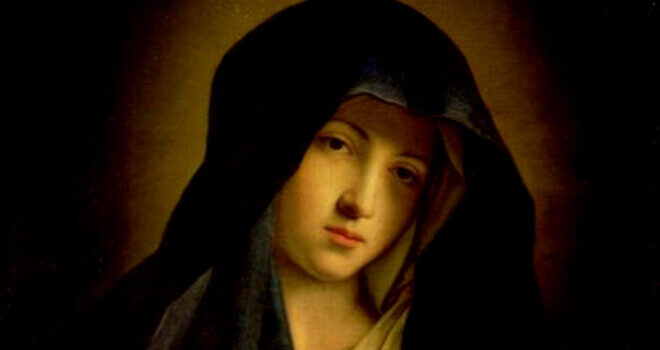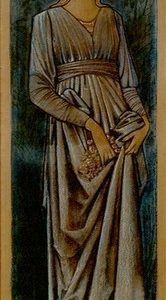Since the Middle Ages, there has been particular emphasis placed on bringing Mary into the mission of redemptive suffering with the Chaplet of Our Lady of Sorrows.
Traces of devotion to Our Lady of Sorrows were present throughout the Church’s first millennium, but it was not until seven noble men retreated to Monte Scenario near Florence, Italy, that a deeper devotion to Mary emerged. These men, dedicated to prayer and penance, held a special reverence for Our Lady.
On Good Friday of 1239, as they contemplated the Passion of Christ and Mary’s suffering, Our Lady appeared to them. She expressed her desire for them to establish an order focused on her sorrows. Heeding her call, they founded the Servants of Mary, also known as the Servites.
Central to their worship was the “Servite Rosary,” now called the Chaplet of the Seven Sorrows of Mary, which involves meditating on Mary’s sorrows. This devotion rapidly expanded across Italy and further.
The Chaplet gained renewed momentum from the visions of St. Bridget of Sweden (1303–1373), who, at ten years old, had a vision revealing the 5,480 blows Jesus endured during His Passion. This vision cemented her deep devotion to Christ’s Passion.
Bridget would experience regular visions of Jesus, Mary, and the angels, often focusing on the sorrowful hearts of Jesus and Mary. In one vision, Our Lady pleaded with St. Bridget:
I look around at everyone in the world to see if there happens to be some who might have compassion on me and be mindful of my sorrow, but I find very few who think about my sorrow and tribulation. This is why, my daughter, although I am forgotten and neglected by many people, you must not forget me! Look at my struggles and imitate them as far as you can! Contemplate my sorrows and tears and be sorry that the friends of God are so few. Stand firm! Look, my Son is coming.1
On March 2, 1982, Mary appeared to Marie Claire Mukangango in Kibeho, Rwanda, and said, “One must meditate on the Passion of Jesus, and on the deep sorrows of His Mother. One must recite the Rosary every day, and the Rosary of the Seven Sorrows of Mary, to obtain the favor of repentance.”2
Marie Claire heeded the call to promote devotion to Mary’s sorrowful heart but passed away just twelve years later (in 1994) amid civil turmoil. Immaculée Ilibagiza, renowned for being the one “left to tell” of Mary’s message, has carried on Marie Claire’s legacy. She has journeyed globally, spreading the message of Our Lady of Kibeho with equal passion and zeal as Marie Claire.
We have witnessed a modern revival of the Servite Rosary with Mary’s appearance in Kibeho. It is now up to us to respond to this call to pray the Chaplet of the Seven Sorrows.
Mary promises three fruits when we pray the Chaplet of the Seven Sorrows of Mary:
Meditating on Mary’s seven sorrows brings her consolation. Meditating on Mary’s seven sorrows will reveal the behaviors that cause her pain and the steps we must take to amend them.Meditating on Mary’s seven sorrows grants us a heart that prays for unrepentant souls.
Each of these fruits are tied directly to the world.
Man’s sin leads to Mary’s broken heart.Our growth in virtue leads to the sanctity of our souls, which impacts our neighbor and world.Our petitions lead to God having mercy on the world.
My dear readers, the word crisis translates to “turning point.” The question that lies before each of us is this: are we going to allow the current crises to become the axle upon which we seek to encounter Christ and repent of our sins? Or, are we going to allow our fears to lead to a defeatist attitude, where we say thing like:
“I don’t feel adequate.”“What’s the point in trying?”“I’m likely to fail, so what’s the use in beginning?”
Secular culture holds self-entitlement and moral relativism in the highest regard, almost as if they were sacred pursuits. These ideologies insist that our choices must be respected, no matter how disastrous or reckless they may be. Such influence has led to a collective defeatist attitude. One might think, “My individual efforts to further God’s kingdom and the triumph of the Immaculate Heart of Mary are insignificant, so I should leave it to the rosary guild, the devoted clergy, and bishops.” However, Mary’s promise—that echoes Scripture—conveys a different message: “Meditate upon my sorrows, and I will draw you closer to my Son. As I do, you will be transformed as will the unrepentant souls you pray for!”
The more we practice mental prayer, actively participate in Mass, recite the Rosary and the Chaplet of the Seven Sorrows, and offer our suffering for the salvation of souls, the more we effect change. Although God does not depend on our prayers to act, He chooses to use our prayers to act, allowing us the honor of participating in His outgoing mercy and love.
Editor’s Note: The authors’ book Contemplating the Seven Sorrows of Mary: A Chaplet with St. Alphonsus Liguori is available from Sophia Institute Press.
Sassoferrato, B. (1609-1685). The Madonna in Sorrow [painting]. Retrieved from Wikimedia Commons.
1The Revelations of St. Bridget of Sweden: Books 1–5, ed. Darrell Wright (self-pub., CreateSpace Independent Publishing, 2016), bk. 2, chap. 24, emphasis added.
2Immaculée Ilibaziga, Our Lady of Kibeho: Mary Speaks to the World from the Heart of Africa (Carlsbad, CA: Hay House, 2010), 185. On June 29, 2001, Augustin Misago, bishop of Gikongoro, released the final judgment, which was also approved by the Holy See, that Our Lady did appear at Kibeho to Alphonsine Mumureke (age seventeen), Nathalie Mukamazimpaka (age twenty), and Marie Clare Mukangango (age twenty-one).










